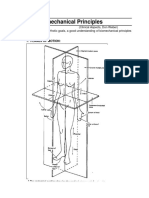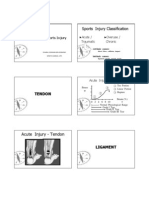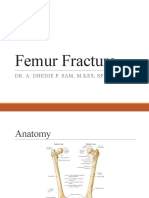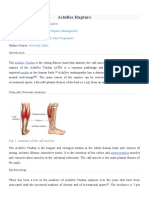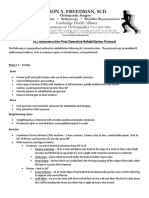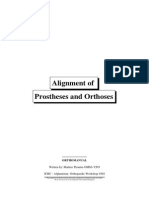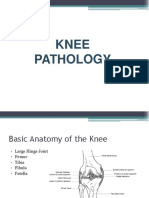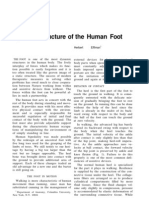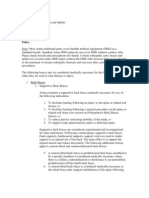Ankle Injury Evaluation
Ankle Injury Evaluation
Uploaded by
ManiDeep ReddyCopyright:
Available Formats
Ankle Injury Evaluation
Ankle Injury Evaluation
Uploaded by
ManiDeep ReddyOriginal Title
Copyright
Available Formats
Share this document
Did you find this document useful?
Is this content inappropriate?
Copyright:
Available Formats
Ankle Injury Evaluation
Ankle Injury Evaluation
Uploaded by
ManiDeep ReddyCopyright:
Available Formats
Journal of Athletic Training 2002;37(4):406–412
q by the National Athletic Trainers’ Association, Inc
www.journalofathletictraining.org
Assessment of the Injured Ankle
in the Athlete
Scott A. Lynch
Pennsylvania State University, Hershey, PA
Scott A. Lynch, MD, provided conception and design; acquisition and analysis and interpretation of the data; and drafting,
critical revision, and final approval of the manuscript.
Address correspondence to Scott A. Lynch, MD, Section of Sports Medicine, Department of Orthopedics and Rehabilitation,
H089, MS Hershey Medical Center, PO Box 850, Hershey, PA 17033-0850. Address e-mail to slynch@psu.edu.
Objective: To present appropriate tools to assist in the as- diographic evaluation and special tests. I will outline techniques
sessment and evaluation of ankle injuries in athletes. for diagnosing the most common ankle injuries among athletes.
Data Sources: A MEDLINE search was performed for the years Conclusions/Recommendations: In order to provide appro-
1980–2001 using the terms ankle injuries and ankle sprains. priate treatment, the examiner must differentiate among injuries
Data Synthesis: Ankle sprains are the most common injuries to the lateral ankle-ligament complex, subtalar joint, deltoid lig-
sustained by athletes. In order to render appropriate treatment, ament, and syndesmosis. It is important to realize that injury
a proper evaluation must be made. Assessment of ankle inju- can occur to any or all of these structures simultaneously.
ries includes obtaining a good history of the mechanism of in- Key Words: ankle sprain, syndesmosis, deltoid ligament,
jury, a thorough physical examination, and judicious use of ra- subtalar joint
I
t is estimated that one ankle sprain occurs per 10 000 per- LATERAL ANKLE-LIGAMENT SPRAINS
sons per day.1–3 Ankle sprains are the most common sports AND INSTABILITY
injury,4,5 accounting for 10% to 15% of sport-related in-
The main lateral soft tissue stabilizers of the ankle are the
juries,6 and are responsible for 7% to 10% of all emergency
ligaments of the lateral ligamentous complex: the anterior talo-
room visits.7 Most of these injuries occur in persons under 35 fibular ligament (ATFL), the calcaneofibular ligament (CFL),
years of age.8 Findings from a recent study9 suggested that and the posterior talofibular ligament (PTFL). In the neutral
women are more at risk for minor ankle sprains than men. position, especially when coupled with compressive loads dur-
Injuries to the lateral-ligament complex caused by ankle in- ing weight bearing, the bony architecture of the ankle joint
version are the most common ankle sprains.6 greatly assists with stability.15 As the foot goes into plantar
Isolated lateral ankle sprains must be differentiated from flexion, thereby dissociating the bony talar contribution to talo-
other sprains. Subtalar-joint sprains often occur with lateral crural stability, the ligamentous structures assume a greater
ankle-ligament sprains but can occur as isolated injuries. Iso- role in providing stability and are more susceptible to injury.
lated subtalar sprains are difficult to diagnose but usually re- The ATFL is a small thickening of the tibiotalar capsule.
spond well to nonoperative treatment. When the foot is in plantar flexion, the ligament courses par-
Isolated medial ankle sprains are relatively uncommon, with allel to the axis of the leg.16,17 Because most sprains occur
most deltoid injuries occurring in combination with lateral when the foot is in plantar flexion, this ligament is most fre-
malleolus fractures or syndesmosis injuries.10 However, iso- quently injured in inversion sprains. The CFL and PTFL are
lated injury to the deltoid ligament can occur during an ever- less commonly injured.18,19 Rupture of these ligaments typi-
sion injury in which the body rolls over an everted foot. The cally occurs in more severe injuries, as the inversion force
anterior fibers of the deltoid are most commonly injured.10 continues posteriorly around the ankle after the ATFL is
Isolated syndesmosis injuries, often referred to as ‘‘high’’ sprained. Isolated injuries of the CFL can occur when the lig-
ament is under maximum strain with the foot in dorsiflexion
ankle sprains, are also relatively uncommon, although they are
but are infrequent. Isolated injuries of the PTFL are extremely
probably underreported in the literature.11 More often, syn-
rare. Most injuries to the PTFL occur with very severe ankle
desmosis injuries are associated with an injury to the anterior sprains in which both the ATFL and CFL have been torn, and
part of the deltoid ligament or fractures of the medial or lateral the forces continue around the lateral aspect of the ankle. Bros-
malleoli (or both).12 The mechanism of injury is combined tröm18 found that isolated, complete rupture of the ATFL was
forced external rotation, dorsiflexion, and axial loading of the present in 65% of all ankle sprains. A combined injury in-
ankle.13 The anterior tibiofibular ligament is the usual site of volving the ATFL and the CFL occurred in 20% of his pa-
injury in isolated sprains.14 Isolated partial tears can be treated tients.
nonoperatively,13 but complete syndesmosis ruptures carry a The extent of tissue damage that occurs during an injury
high risk for chronic pain, arthrosis, or ankle instability and depends on the direction and magnitude of the forces and the
are best treated surgically.14 position of the foot and ankle during the trauma. Ankle sprains
406 Volume 37 • Number 4 • December 2002
Figure 1. Typical ankle-inversion injury. Note the plantar-flexed an-
kle.
Figure 2. Anterior drawer test. The ankle is held between neutral
and 108 of plantar flexion, and the calcaneus is pulled anteriorly
occur significantly more often in athletes who have had pre- while the tibia is held stable.
vious ankle sprains.20 Pes cavus, rearfoot varus, tibial varus,
and previous trauma are factors that may contribute to ankle-
inversion injury, although none of these have been scientifi-
cally verified as contributing factors.
Evaluation
The most common mechanism of injury is an athlete who
‘‘rolled’’ over the outside of his or her ankle (Figure 1). This
usually occurs as either a noncontact injury or when the athlete
lands from a step or jumps onto an opponent’s foot with an
inverted foot. The foot is usually plantar flexed at the time of
the injury. Many patients state that they have heard something
‘‘snap’’ during the trauma; however, feeling a tearing sensation
or hearing a snap does not appear to correlate with the severity
of the injury.8 The main site of pain and swelling is usually
localized to the lateral side of the ankle over the ATFL. Sev-
eral hours after the injury, generalized swelling and pain can
make the evaluation more difficult and less reliable. Most pa-
tients have pain and discomfort when trying to ambulate on Figure 3. Talar tilt test. The calcaneus and talus are grasped as a
the injured extremity. Ecchymosis can occur 24 to 48 hours unit and tilted into inversion. The tibia is held stable with the ankle
after the injury. The discoloration is usually worst along the in neutral dorsiflexion.
lateral side but can also occur in the retrocalcaneal bursal area
and along the heel because of the potential space available for
swelling and the pooling effect of gravity. It is important that sitting with the knee flexed to relax the calf muscles and pre-
the entire leg, ankle, and foot be examined to ensure that no vent the patient from actively guarding against the examiner.
other injuries have occurred. With tenderness over the mid- The examiner grasps the heel firmly in one hand and pulls
shaft of the fibula or medial-side tenderness and swelling, the forward while holding the anterior aspect of the distal tibia
examiner should be suspicious of fracture or more significant stable with the other hand (Figure 2). The sensitivity of the
injury. test can be improved by placing the ankle in 108 of plantar
Clinical stability tests for ligamentous disruption are best flexion.26 Increased anterior translation of the talus with re-
performed between 4 and 7 days after the injury, when the spect to the tibia is a positive sign and indicates a tear of the
acute pain and swelling are diminished and the patient is able ATFL, particularly if the translation is significantly different
to relax during the examination.21 The anterior drawer test is from the opposite side. However, how much translation is
more specific for assessing the integrity of the ATFL, and the physiologically normal is the subject of disagreement: it has
talar tilt test is more specific for detecting injury to the CFL. been reported to be anywhere from 2 mm to 9 mm.27,28 There-
These findings are best recorded as differences between the fore, it is better to compare the amount of pathologic anterior
ankles (assuming the opposite ankle is uninjured), but the tests laxity with the normal side. This analysis by the examiner is
can still be difficult to interpret, and the results often vary subjective, and agreement among observers varies.
greatly among examiners.22,23 Caution must be exercised in The talar tilt test is defined as the angle produced by the
interpreting these tests, but a positive test can help to confirm tibial plafond and the dome of the talus in response to forceful
the diagnosis in a patient with a suspicious history.18,24,25 inversion of the hindfoot. The talar tilt test is performed with
The anterior drawer test evaluates ATFL integrity by the the ankle in the neutral position. The examiner holds the heel
amount of anterior-talar displacement that can be produced in stable while trying to invert the heel with respect to the tibia
the sagittal plane. To perform this test, the patient should be (Figure 3). It is important to try to grasp the talus and calca-
Journal of Athletic Training 407
neus as a unit to limit subtalar motion during the test. As in
the anterior drawer examination, the results from the talar tilt
test are difficult to interpret, with reports indicating normal
values between 58 and 238,29,30 but as a general rule, more
than 108 difference from the normal side is considered abnor-
mal.31
A new testing device developed by Kirk et al32 applies stan-
dardized loads for both the anterior drawer and talar tilt tests.
At an anterior force of 111 N (25 lbs) and a torque of 16 Nm,
the mean anterior-drawer translation was 5.9 mm, and the
mean talar-tilt translation was 518. The device has not yet been
adopted into widespread use.
Radiographic Analysis
Clinical guidelines for determining the necessity of radio-
graphs have been developed to limit the number of radio-
graphs. These guidelines carry tremendous potential for cost
savings. The Ottawa Ankle Rules (OAR) are the commonly
used criteria for predicting which patients require radiographic
images.33 Radiographs are only required for those patients
with (1) tenderness at the posterior edge or tip of the medial
or lateral malleolus; (2) inability to bear weight (4 steps) either
immediately after the injury or in the emergency room; or (3)
pain at the base of the fifth metatarsal. Following these rules
provided nearly 100% sensitivity for detecting fractures while
significantly reducing the number of unnecessary radio-
graphs.33 Standard radiographs, if necessary, should include
anteroposterior (AP), lateral, and mortise views. The mortise
view is an AP view with the tibia internally rotated by 158 to
208. This position allows evaluation of the syndesmosis and
assessment of mortise disruption. In the mortise view, the talus
should be equidistant from both malleoli.
Stress radiography for acute injuries will not change the
treatment protocol and is generally not indicated. These tech-
niques are more often used for research purposes or to differ-
entiate between mechanical instability and functional instabil-
ity in patients with chronic ankle problems. Specialized
instruments have been developed to apply standardized loads
during the stress radiographs. The anterior-drawer stress radio-
graph is more sensitive for ATFL insufficiency, and the talar-
tilt stress radiograph is more sensitive for CFL integrity. How-
ever, the amount of displacement that represents a pathologic
condition is variable. The most commonly used criteria for the
anterior-drawer stress test are those of Karlsson,31 who defined
abnormal laxity as an absolute anterior displacement of 10 mm
or a side-to-side difference of more than 3 mm (Figure 4).
Abnormal talar tilt is even more controversial due to the large
variation in ‘‘normal’’ talar tilt, which is reported to be from
08 to 278.19,31,34,35 A talar tilt of 158 more than the normal
side correlated with a complete double-ligament rupture
(ATFL and CFL).19 As a general rule, a finding of more than
108 greater than the normal side is considered abnormal (Fig-
ure 5).28
If the results of the 2 stress-radiographic images are com-
bined, the sensitivity of the tests increases to 68%, but the
specificity falls to 71%21; therefore, it is difficult to recom-
mend routine use of stress radiography.
Ankle-joint arthrography is a sensitive and specific diag- Figure 4. Anterior-drawer stress test. A, schematic drawing, and B,
nostic test for ligament ruptures,36,37 as shown by Lahde et radiograph. (Copyright 2002 by the Hughston Sports Medicine
al,22 who studied 7000 ankle arthrographies performed over a Foundation, Inc).
15-year period. But they also found limitations of arthrogra-
phy: it is reliable only within the first 24 to 48 hours, cannot
408 Volume 37 • Number 4 • December 2002
drawback to this system is that, unless the injury is treated
surgically, objective evidence of injury to each ligament is
lacking. Finally, because of the problems of these grading sys-
tems, a classification based on clinical severity has been used.
This system has 3 clinical grades: grade I (mild), grade II
(moderate), and grade III (severe).16,17 A grade I injury in-
volves little swelling and tenderness, minimal or no functional
loss, and no mechanical joint instability. A grade II injury has
moderate pain, swelling, and tenderness over the involved
structures; some joint motion is lost, and joint instability is
mild to moderate. A grade III injury is a complete ligament
rupture with marked swelling, hemorrhage, and tenderness;
function is lost, and joint motion and instability are markedly
abnormal. Grading of ankle sprains remains a largely subjec-
tive interpretation, and agreement among independent observ-
ers varies.
Differential Diagnosis
Other problems can mimic, or be coupled with, lateral an-
kle-ligament sprains. Fractures of the ankle are often associ-
ated with ankle-ligament injuries.12 In particular, the exami-
nation should focus on potential fractures of the lateral,
medial, and posterior malleolus; proximal fibula; lateral or
posterior process of the talus; anterior process of the calca-
neus; fifth metatarsal; navicular or other midtarsal bones; and
children’s epiphyseal separations.
Figure 5. Talar-tilt stress radiograph. (Copyright 2002 by the Patients with stress fractures about the ankle joint may pre-
Hughston Sports Medicine Foundation, Inc.) sent with a different type of history but similar symptoms. In
particular, a transverse, proximal diaphyseal fracture of the
fifth metatarsal bone (Jones fracture) can mimic an acute lat-
quantify the severity of ligament damage, and is an invasive eral ankle sprain.33 This is particularly true when an acute
procedure. Proper interpretation of arthrographic images re- fracture occurs through an area of previous stress reaction that
quires a full understanding of the variant and natural leakage may have had minimal or no symptoms. The distal fibula,
of contrast. Arthrography is a valuable research tool, but it is medial malleolus, calcaneus, navicular, and metatarsals are
rarely indicated for clinical use because it does not change the also prone to stress fracture.
treatment protocol. Osteochondral fractures or osteochondritis dissecans of the
Similarly, magnetic resonance imaging (MRI) and comput- talar dome or the tibial plafond can occur with lateral ankle-
ed tomography (CT) scanning are rarely necessary for typical ligament sprains.38 These fractures can become chronic prob-
acute ankle sprains because the results do not affect the treat- lems, with continued pain and recurrent instability episodes.
ment protocol. Gaebler et al19 compared intraoperative find- If plain radiographs are negative despite continued pain, a
ings with MRI results in 25 patients who had a talar tilt greater bone scan, CT scan, or MRI may be helpful to evaluate for
than 158 and found that MRI was reliable in diagnosing lateral- this lesion.38 Arthroscopy is the definitive test for the diagnosis
ligament injuries. Magnetic resonance imaging and CT scan- and treatment of these fractures.
ning have been useful for identifying osteochondral injuries Athletes with sprains of the subtalar joint or midfoot liga-
that may mimic, or occur in conjunction with, chronic lateral ments can present with a similar history.39 In particular, the
ankle instability.38 dorsal calcaneocuboid ligament, bifurcate ligament, cervical
ligament, and interosseous talocalcaneal ligament are prone to
injury.
Grading Lateral Ankle-Ligament Sprains Subluxation or dislocation of the peroneal tendons can mim-
Several lateral ankle-ligament grading systems have been ic an ankle sprain.40 However, these injuries typically occur
used. This makes comparison in the literature difficult, as by a violent dorsiflexion and pronation moment of the ankle
many authors did not state which grading system they used. instead of the typical inversion injury of lateral-ligament in-
The traditional grading system for ligament injuries focuses on juries.40
a single ligament, with a grade I injury representing a micro-
scopic injury without stretching of the ligament on a macro- SUBTALAR-JOINT SPRAINS AND INSTABILITY
scopic level. A grade II injury has macroscopic stretching, but
the ligament remains intact. A grade III injury is a complete The incidence of subtalar sprains is unknown, mainly due
rupture of the ligament.31 Applying this grading system to lat- to the difficulty of assessing these injuries and the common
eral ankle-ligament sprains addresses only the status of the association with lateral ankle-ligament sprains. They are prob-
ATFL and ignores injury to either the CFL or PTFL. Some ably more common than appreciated. Meyer et al39 studied
authors have thus resorted to grading lateral ankle-ligament subtalar arthrograms in 40 patients with acute ankle sprains
sprains by the number of ligaments injured.18,19,24 The major and found that 17 (43%) had subtalar-ligament injury. Fortu-
Journal of Athletic Training 409
nately, the incidence of chronic ankle problems is low, with
subtalar instability present in only about 10% of patients who
present with chronic lateral ankle-ligament instability.41 Pa-
tients with acute subtalar sprains seem to do well with non-
operative treatment similar to that used for acute lateral ankle-
ligament sprains. However, since the definition and diagnosis
of subtalar sprains are not agreed upon in the literature, this
is difficult to prove.
Acute symptoms of subtalar sprains are similar to, and can
occur with or be masked by, lateral ankle-ligament sprains.
Tenderness over the subtalar joint is characteristic but can be
difficult to differentiate from the tibiotalar joint because of the
close proximity and the swelling that obscures the anatomy.
Clinical evaluation of subtalar instability is very difficult
and unreliable. An evaluation of the change in angle between
the heel and the tibia with passive inversion and eversion of
the heel can be made by comparing this angle with that on the
uninjured side,41 but the sensitivity and specificity of this test
is unknown.
Radiographs should be obtained as per the Ottawa ankle
rules.33 Subtalar stress radiographs,42 subtalar arthrography,39
or stress tomography41 can show increased motion and differ-
entiate between subtalar and talocrural motion; however, most
of these injuries can be effectively treated by rehabilitation, so
specialized studies are usually unnecessary. If surgery is con-
sidered, stress radiographs may be helpful in planning the sur-
gery.
Classification of Subtalar-Joint Sprains
Subtalar-joint sprains are classified by the injury mechanism
and the degree of ligamentous damage.39 The injury can occur
in either plantar flexion or dorsiflexion. Forceful supination
with the foot in plantar flexion tears the ATFL (and possibly
Figure 6. Radiographic measurements of deltoid and syndesmosis
the cervical ligament), followed by either disruption of the injuries. (Adapted with permission from Harper MC. The deltoid
CFL and lateral capsule (type 1) or tearing of the interosseous ligament: an evaluation of need for surgical repair. Clin Orthop.
talocalcaneal ligament (type 2). When the ankle is in dorsi- 1988;226:156–158; Lippincott Williams & Wilkins.10)
flexion, the ATFL is not under tension and remains uninjured.
This type of injury tears the CFL, the cervical ligament, and
the interosseous talocalcaneal ligament (type 3). A type 4 sub- to the lateral side of the foot, placing a large abduction force
talar sprain is a rupture of all lateral and medial capsuloliga- onto the ankle and deltoid ligament. Because the forces re-
mentous components of the posterior tarsus. This injury occurs quired to injure the strong deltoid ligament are so great, the
as the foot moves from dorsiflexion to plantar flexion while injury usually continues through the syndesmosis by the strong
forceful hindfoot supination occurs.39 lever action of the lateral malleolus on the lateral aspect of the
talus.12
DELTOID LIGAMENT TEARS
Evaluation
In Broström’s18 series of 281 acute ankle sprains, medial-
side ankle sprains constituted only 3%. Nearly all of the me- Deltoid ligament injuries cause pain, tenderness, and swell-
dial-side injuries were partial ligament tears. Complete deltoid ing on the medial side of the ankle. A defect may be palpable
ligament ruptures most often occur in combination with ankle below the medial malleolus in complete ruptures. If a deltoid
fractures. In Harper’s10 review of 42 patients with complete ligament injury is present, it is extremely important to evaluate
deltoid ligament ruptures, all had other injuries. In the ankle- the ankle for a syndesmosis sprain or fracture. The entire fib-
fracture classification described by Lauge-Hansen,12 a deltoid ula, including the proximal third and proximal tibiofibular
ligament tear or medial malleolar fracture occurs as the injury joint, must also be palpated to rule out complete syndesmosis
pattern continues around the ankle in a circular fashion. The disruption.
3 most characteristic mechanisms of injury of the deltoid lig- For medial-side injuries, radiographs are necessary to eval-
ament are pronation-abduction, pronation-external rotation, uate the bony structures and syndesmosis. The minimum ra-
and supination-external rotation of the foot.12,43,44 The first diographic series includes AP, lateral, and mortise views. If
component describes the position of a planted foot, and the there is any suspicion for a proximal fibular fracture, AP and
second term indicates the relative motion of the foot as the leg lateral radiographs of the entire tibia and fibula should be tak-
rotates about the planted foot. So, in the pronation-abduction en. If the deltoid ligament and syndesmosis are both complete-
injury, the foot is planted in pronation as the upper body falls ly disrupted, the medial clear space between the medial talus
410 Volume 37 • Number 4 • December 2002
and the lateral border of the medial malleolus will be widened
to 4 mm or more (Figure 6).45,46 However, isolated deltoid
ruptures do not cause widening of the medial clear space be-
cause the lateral malleolus holds the talus in position. Simi-
larly, syndesmosis injuries without deltoid tears do not have
medial joint-space widening. In this case, the inferior tibiofib-
ular joint must be carefully evaluated for syndesmosis injury.
Eversion-stress radiographs, arthrography, or MRI may be
helpful in difficult cases, but the diagnosis can most often be
made with clinical examination and plain radiographs.
TIBIOFIBULAR SYNDESMOSIS TEARS: ‘‘HIGH’’
ANKLE SPRAINS
Partial or complete rupture of the syndesmosis ligament
complex can cause diastasis of the inferior tibiofibular joint.47
Isolated complete syndesmosis injuries are rare, and relatively
little information exists in the literature about ankle diastasis
in the absence of fracture. Fritschy48 reported only 12 cases
of complete isolated syndesmosis ruptures in a series of more
than 400 ankle-ligament ruptures. All 12 injuries were caused Figure 7. Dorsiflexion and external-rotation stress test for syndes-
by a sudden external rotation of the ankle that caused the talus mosis injury. The tibia is held stable while the foot is dorsiflexed
to pry the fibula laterally, thus opening the distal tibiofibular and externally rotated.
articulation.
Isolated partial syndesmosis injuries occur with some fre-
quency, and their incidence is probably underreported in the and osseous avulsions and to evaluate syndesmosis widening.
literature. It is important to recognize that syndesmosis in- In athletes with possible syndesmosis widening or proximal
volvement generally increases recovery time 2- or 3-fold over fibular tenderness, AP and lateral films of the entire tibia and
that for a lateral ankle-ligament sprain. Early diagnosis of the fibula are necessary to rule out a Maisonneuve fracture. Ac-
syndesmosis sprain can help to give the athlete and coaches ceptable radiographic guidelines that indicate syndesmosis di-
realistic expectations of return to play. Nussbaum et al13 sug- astasis are controversial, and measurements can be affected
gested that the expanse of the syndesmosis tenderness was greatly by the amount of tibial rotation. The most commonly
predictive of recovery time, with more syndesmosis tenderness used guidelines are a joint-space widening of greater than 5
correlating with more playing days missed. However, it is mm or a tibiofibular overlap of less than 10 mm, both as mea-
much more common for the injury to be associated with a sured on the AP view. Other authors prefer to use the ratio of
fracture or deltoid ligament injury (or both).12 With ankle frac- measurements to the fibular width.50 Ninety percent predictive
tures, the frequency of syndesmosis ruptures is related to the intervals for a normal relationship were a tibiofibular overlap-
type and level of associated fibular fractures.12 Syndesmosis to-fibular width ratio greater than 24% and a tibiofibular clear
injuries are more common as the level of the fibular fracture space-to-fibular width ratio of less than 44%, both as measured
rises above the level of the ankle joint, as predicted by the on the AP radiograph.50 Stress radiographs with the foot in
Lauge-Hansen12 injury-mechanism classification of ankle frac- external rotation in both dorsiflexion and plantar flexion may
tures. In this classification scheme, ligamentous injuries or demonstrate the diastasis.48 Magnetic resonance imaging has
fractures occur as the rotatory forces continue around the ankle now become the test of choice for evaluating the syndesmosis
in a circular fashion.12 in difficult cases.51
Evaluation CONCLUSIONS
In order to provide appropriate treatment after an athlete
Pain and tenderness are located primarily on the anterior
sprains an ankle, a thorough evaluation is necessary. This
aspect of the syndesmosis and interosseous membrane. Active
should include the mechanism of injury, physical examination,
and passive external rotation of the foot is painful. The exter-
and appropriate radiographic studies and special tests. The in-
nal-rotation test is performed by externally rotating the foot
jury can affect the lateral ankle-ligament complex, the subtalar
with the ankle in dorsiflexion (Figure 7), which stresses the
joint, the deltoid ligament, or the syndesmosis or any combi-
syndesmosis by levering the talus against the lateral malleolus.
nation of these structures simultaneously. Defining the extent
Patients with a syndesmosis injury have pain over the anterior
of injury allows the clinician to institute the proper treatment
inferior tibiofibular ligament and joint. The squeeze test is per-
regimen in preparation for the athlete’s safe return to sport.
formed by compressing the midshaft of the tibia and fibula
together. If a syndesmosis injury is present, the patient has
pain at the inferior tibiofibular joint. Biomechanical studies REFERENCES
have confirmed distal tibiofibular motion during the squeeze 1. Brooks SC, Potter BT, Rainey JB. Treatment for partial tears of the lateral
test.49 ligament of the ankle: a prospective trial. Br Med J (Clin Res Ed). 1981;
Radiographs should be taken according to the Ottawa ankle 282:606–607.
rules as outlined in the previous sections.33 Anteroposterior, 2. McCulloch PG, Holden P, Robson DJ, Rowley DI, Norris SH. The value
lateral, and mortise views may be needed to exclude fractures of mobilisation and non-steroidal anti-inflammatory analgesia in the man-
Journal of Athletic Training 411
agement of inversion injuries of the ankle. Br J Clin Pract. 1985;2:69– 27. Johannsen A. Radiological diagnosis of lateral ligament lesion of the an-
72. kle. Acta Orthop Scand. 1978;49:295–301.
3. Ruth C. The surgical treatment of injuries of the fibular collateral liga- 28. Karlsson J, Bergsten T, Lansinger O, Peterson L. Surgical treatment of
ments of the ankle. J Bone Joint Surg Am. 1961;43:229–239. chronic lateral instability of the ankle joint: a new procedure. Am J Sports
4. Lassiter TE Jr, Malone TR, Garrett WE Jr. Injury to the lateral ligaments Med. 1989;17:268–274.
of the ankle. Orthop Clin North Am. 1989;20:629–640. 29. Cox JS. Surgical and nonsurgical treatment of acute ankle sprains. Clin
5. McConkey JP. Ankle sprains, consequences and mimics. Med Sport Sci. Orthop. 1985;198:118–126.
1987;23:39–55. 30. Rubin G, Whitten M. The talar tilt angle and fibular collateral ligaments:
6. MacAuley D. Ankle injuries: same joint, different sports. Med Sci Sports a method for the determination of talar tilt. J Bone Joint Surg Am. 1960;
Exerc. 1999;31(7 suppl):409–411. 42:311–326.
7. Viljakka T, Rokkanen P. The treatment of ankle sprain by bandaging and 31. Karlsson J. Chronic Lateral Instability of the Ankle [master’s thesis].
antiphlogistic drugs. Ann Chir Gynaecol. 1983;72:66–70. Göteborg, Sweden: Göteborg University; 1989:158.
8. Nilsson S. Sprains of the lateral ankle ligaments, part II: epidemiological 32. Kirk T, Saha S, Bowman LS. A new ankle laxity tester and its use in the
and clinical study with special reference to different forms of conservative measurement of the effectiveness of taping. Med Eng Phys. 2000;22:723–
treatment. J Oslo City Hosp. 1983;33:13–36. 731.
9. Hosea TM, Carey CC, Harrer MF. The gender issue: epidemiology of 33. Stiell IG, Greenberg GH, McKnight RD, Nair RC, McDowell I. A study
ankle injuries in athletes who participate in basketball. Clin Orthop. 2000; to develop clinical decision rules for the use of radiography in acute ankle
372:45–49. injuries. Ann Emerg Med. 1992;21:384–390.
10. Harper MC. The deltoid ligament: an evaluation of need for surgical 34. Perlman M, Leveille D, DeLeonibus J, et al. Inversion lateral ankle trau-
repair. Clin Orthop. 1988;226:156–168. ma: differential diagnosis, review of the literature, and prospective study.
11. Boytim MJ, Fischer DA, Neumann L. Syndesmotic ankle sprains. Am J J Foot Surg. 1987;26:95–135.
Sports Med. 1991;19:294–298. 35. Cox JS, Hewes TF. ‘‘Normal’’ talar tilt angle. Clin Orthop. 1979;140:37–
12. Lauge-Hansen N. Fractures of the ankle, II: combined experimental sur- 41.
gical and experimental roentgenologic investigation. Arch Surg. 1950;60: 36. Broström L. Sprained ankles, 3: clinical observations in recent ligament
957–985. ruptures. Acta Chir Scand. 1965;130:560–569.
13. Nussbaum ED, Hosea TM, Sieler SD, Incremona BR, Kessler DE. Pro- 37. van Moppens Fl, van den Hoogenband CR. Diagnostic and Therapeutic
spective evaluation of syndesmotic ankle sprains without diastasis. Am J Aspects of Inversion Trauma of the Ankle Joint [master’s thesis]. Maas-
Sports Med. 2001;29:31–35. tricht, Netherlands: University of Maastricht; 1992.
14. Ogilvie-Harris DJ, Reed SC. Disruption of the ankle syndesmosis: diag- 38. Lazarus ML. Imaging of the foot and ankle in the injured athlete. Med
nosis and treatment by arthroscopic surgery. Arthroscopy. 1994;10:561– Sci Sport Exerc. 1999;31(7 suppl):412–420.
568. 39. Meyer JM, Garcia J, Hoffmeyer P, Fritschy D. The subtalar sprain: a
15. Stormont DM, Morrey BF, An KN, Cass JR. Stability of the loaded ankle: roentgenographic study. Clin Orthop. 1988;226:169–173.
relation between articular restraint and primary and secondary static re- 40. Safran MR, O’Malley D Jr, Fu FH. Peroneal tendon subluxation in ath-
straints. Am J Sports Med. 1985;13:295–300. letes: new exam technique, case reports, and review. Med Sci Sports Ex-
16. Balduini FC, Tetzlaff J. Historical perspectives on injuries of the liga- erc. 1999;31(7 suppl):487–492.
ments of the ankle. Clin Sports Med. 1982;1:3–12. 41. Brantigan JW, Pedegana LR, Lippert FG. Instability of the subtalar joint:
17. Balduini FC, Vegso JJ, Torg JS, Torg E. Management and rehabilitation diagnosis by stress tomography in three cases. J Bone Joint Surg Am.
of ligamentous injuries to the ankle. Sports Med. 1987;4:364–380. 1977;59:321–324.
18. Broström L. Sprained ankles, I: anatomic lesions in recent sprains. Acta 42. Laurin CA, Ouellet R, St-Jacques R. Talar and subtalar tilt: an experi-
Chir Scand. 1964;128:483–495. mental investigation. Can J Surg. 1968;11:270–279.
19. Gaebler C, Kukla C, Breitenseher MJ, et al. Diagnosis of lateral ankle 43. Sclafani SJ. Ligamentous injury of the lower tibiofibular syndesmosis:
ligament injuries: comparison between talar tilt, MRI and operative find- radiographic evidence. Radiology. 1985;156:21–27.
ings in 112 athletes. Acta Orthop Scand. 1997;68:286–290. 44. Yde J. The Lauge-Hansen classification of malleolar fractures. Acta Or-
20. Sitler M, Ryan J, Wheeler B, et al. The efficacy of a semirigid ankle thop Scand. 1980;51:181–192.
stabilizer to reduce acute ankle injuries in basketball: a randomized clin- 45. Grath GB. Widening of the ankle mortise. Acta Chir Scand. 1960;263:1–7.
ical study at West Point. Am J Sports Med. 1994;22:454–461. 46. Harper MC. An anatomic study of the short oblique fracture of the distal
21. Van Dijk CN. On Diagnostic Strategies in Patients with Severe Ankle fibula and ankle stability. Foot Ankle. 1983;4:23–29.
Sprain [master’s thesis]. Amsterdam, Netherlands: University of Amster- 47. Marymont JV, Lynch MA, Henning CE. Acute ligamentous diastasis of
dam; 1994. the ankle without fracture: evaluation by radionuclide imaging. Am J
22. Lahde S, Putkonen M, Puranen J, Raatikainen T. Examination of the Sports Med. 1986;14:407–409.
sprained ankle: anterior drawer test or arthrography? Eur J Radiol. 1988; 48. Fritschy D. An unusual ankle injury in top skiers. Am J Sports Med.
8:255–257. 1989;17:282–286.
23. Rasmussen O. Stability of the ankle joint: analysis of the function and 49. Teitz CC, Harrington RM. A biomechanical analysis of the squeeze test
traumatology of the ankle ligaments. Acta Orthop Scand Suppl. 1985; for sprains of the syndesmotic ligaments of the ankle. Foot Ankle Int.
211:1–75. 1998;19:489–492.
24. Chapman MW. Sprains of the ankle. Instr Course Lect. 1975;24:294–308. 50. Ostrum Rf, De Meo P, Subramanian R. A critical analysis of the anterior-
25. Ryan JB, Hopkinson WJ, Wheeler JH, Arciero RA, Swain JH. Office posterior radiographic anatomy of the ankle syndesmosis. Foot Ankle Int.
management of the acute ankle sprain. Clin Sports Med. 1989;8:477–495. 1995;16:128–131.
26. Renström P, Theis M. Biomechanics and function of ankle ligaments: 51. Vogl TJ, Hochmuth K, Diebold T, et al. Magnetic resonance imaging in
experimental results and clinical application. Sportverletz Sportschaden. the diagnosis of acute injured distal tibiofibular syndesmosis. Invest Ra-
1993;7:29–35. diol. 1997;32:401–409.
412 Volume 37 • Number 4 • December 2002
You might also like
- Smart GoalsDocument1 pageSmart Goalsapi-549804095No ratings yet
- For Personal Use Onl Y of Gomesh Karnchanapayap 10/56 Townplus Rama 9 Krungthep Kreetha. Bangkok 10240 All Rights Reserved by Exonicus LLCDocument228 pagesFor Personal Use Onl Y of Gomesh Karnchanapayap 10/56 Townplus Rama 9 Krungthep Kreetha. Bangkok 10240 All Rights Reserved by Exonicus LLCViolett ShyNo ratings yet
- Ankle Instability: Dr. Syarif Hidayatullah, SP - OT, M.KesDocument75 pagesAnkle Instability: Dr. Syarif Hidayatullah, SP - OT, M.Kesahmad zakyNo ratings yet
- Hip Neck Fracture, A Simple Guide To The Condition, Diagnosis, Treatment And Related ConditionsFrom EverandHip Neck Fracture, A Simple Guide To The Condition, Diagnosis, Treatment And Related ConditionsNo ratings yet
- 2018 Hip Program FINALDocument119 pages2018 Hip Program FINALJafild Fild riverNo ratings yet
- Meniscus RepairDocument14 pagesMeniscus Repairapi-547954700No ratings yet
- Pes Planus and Pes Valgus DR BijayDocument60 pagesPes Planus and Pes Valgus DR BijayBijay MehtaNo ratings yet
- ACL Reconstruction ProtocolDocument23 pagesACL Reconstruction ProtocolAdrianAelenei100% (1)
- Evaluation of Low Back Pain (Ray)Document81 pagesEvaluation of Low Back Pain (Ray)Naeem AminNo ratings yet
- The Knee: University College Hospital LondonDocument35 pagesThe Knee: University College Hospital Londonmicheal1960No ratings yet
- ACL Return To Sport Guidelines and CriteriaDocument8 pagesACL Return To Sport Guidelines and CriteriaCamila Nicole Madrid GonzalezNo ratings yet
- Case 2Document19 pagesCase 2jagdish030798No ratings yet
- Hip PT AssessmentDocument57 pagesHip PT Assessmentkrissh20No ratings yet
- Spondylolysis Non Operative Rehabilitation GuidelineDocument5 pagesSpondylolysis Non Operative Rehabilitation GuidelineAndroid HomeNo ratings yet
- Protocol Hamstring Lengthened Eccentric Training 15214 PDFDocument9 pagesProtocol Hamstring Lengthened Eccentric Training 15214 PDFkang soon cheolNo ratings yet
- Torn Meniscus A Sports InjuryDocument35 pagesTorn Meniscus A Sports InjuryPradeep RajNo ratings yet
- PCL ProtocolDocument5 pagesPCL ProtocolZ TariqNo ratings yet
- Hip InjuriesDocument24 pagesHip Injuriesmariajaved0089No ratings yet
- Conservative Treatment For Meniscus RehabilitationDocument2 pagesConservative Treatment For Meniscus RehabilitationShahroz Khan100% (1)
- Case Studies Low Back Pain in The AthleteDocument37 pagesCase Studies Low Back Pain in The AthleteNovie AstiniNo ratings yet
- Medial Collateral Ligament Injury MCL Rehabilitation Yale 240271 28716Document8 pagesMedial Collateral Ligament Injury MCL Rehabilitation Yale 240271 28716Raluca Alexandra PlescaNo ratings yet
- Patellofemoral/Chondromalacia Protocol: Anatomy and BiomechanicsDocument8 pagesPatellofemoral/Chondromalacia Protocol: Anatomy and BiomechanicsRia PuputNo ratings yet
- Accessory Navicular BoneDocument29 pagesAccessory Navicular BonePhysiotherapist AliNo ratings yet
- ACL and PCL RehabilitationDocument7 pagesACL and PCL RehabilitationYae PhiphatwuthithornNo ratings yet
- PLC InjuryDocument5 pagesPLC InjuryTeng HanNo ratings yet
- Shoulder DislocationDocument10 pagesShoulder DislocationStephanie AureliaNo ratings yet
- Taping Techniques: DR Satbir Singh, MBBS, DSM, Sports Medicine Consultant and Fitness TrainerDocument25 pagesTaping Techniques: DR Satbir Singh, MBBS, DSM, Sports Medicine Consultant and Fitness TrainerAjay Pal NattNo ratings yet
- Coxa Vera and VelgaDocument27 pagesCoxa Vera and VelgaAyesha ShafiqNo ratings yet
- BFO-Basic Biomechanical PrinciplesDocument16 pagesBFO-Basic Biomechanical PrinciplesnovitaNo ratings yet
- 5.classification of Sports InjuriesDocument6 pages5.classification of Sports InjuriesCt KadejaNo ratings yet
- RT Shoulder Rehab Pt1Document3 pagesRT Shoulder Rehab Pt1Char LeeNo ratings yet
- Exploring Advances in THADocument73 pagesExploring Advances in THABridgit FinleyNo ratings yet
- Achilles Tendon Rupture Metatarsal RuptureDocument26 pagesAchilles Tendon Rupture Metatarsal RuptureStar CruiseNo ratings yet
- Biomechanics of KneeDocument78 pagesBiomechanics of KneeDr. Sabari ManokaranNo ratings yet
- 8.8.2017 - Fracture of FemurDocument57 pages8.8.2017 - Fracture of FemurUlfa Sari Al-Bahmi100% (1)
- Bursitis - An Overview of Clinical Manifestations, Diagnosis, and Management - UpToDateDocument16 pagesBursitis - An Overview of Clinical Manifestations, Diagnosis, and Management - UpToDateDannyGutierrezNo ratings yet
- Arches of FootDocument68 pagesArches of FootPoojitha reddy MunnangiNo ratings yet
- Anterior Cruciate Ligament InjuriesDocument16 pagesAnterior Cruciate Ligament InjuriesAlmas PrawotoNo ratings yet
- Achilles RuptureDocument23 pagesAchilles RupturePhysiotherapist AliNo ratings yet
- ACL Reconstruction Post Operative Rehabilitation Protocol: Phase I: 1 - 14 Days GoalsDocument5 pagesACL Reconstruction Post Operative Rehabilitation Protocol: Phase I: 1 - 14 Days GoalsFábio SantosNo ratings yet
- Hip and Knee ConditionsDocument26 pagesHip and Knee ConditionsSreekar ReddyNo ratings yet
- Kinetic ChainDocument9 pagesKinetic ChainCarol LimaNo ratings yet
- Low Back PainDocument7 pagesLow Back PainPutriDundaNo ratings yet
- Physical Therapy in Sport: Ryan Lobb, Steve Tumilty, Leica S. ClaydonDocument9 pagesPhysical Therapy in Sport: Ryan Lobb, Steve Tumilty, Leica S. Claydonilona ilincaNo ratings yet
- Hip Dislocations and Femoral Head Fractures: John T. Gorczyca, MDDocument97 pagesHip Dislocations and Femoral Head Fractures: John T. Gorczyca, MDLassie LazyNo ratings yet
- ArtosDocument22 pagesArtosRia Rahmadiyani IINo ratings yet
- Alignment of Prostheses and Orthoses: Written By: Markus Thonius OMM / CPO ICRC - Afghanistan Orthopaedic Workshop 1992Document27 pagesAlignment of Prostheses and Orthoses: Written By: Markus Thonius OMM / CPO ICRC - Afghanistan Orthopaedic Workshop 1992Alfionita WikaNo ratings yet
- Discoid MeniscusDocument22 pagesDiscoid Meniscusonehipsa0% (1)
- Rehabilitation Protocol For Achilles Tendon RepairDocument10 pagesRehabilitation Protocol For Achilles Tendon Repairckpravin7754No ratings yet
- Biomechanics BasicsDocument75 pagesBiomechanics BasicsAlban Presley R. SangmaNo ratings yet
- Deformities OF The Lower Limb: DR - Tehreem NasirDocument57 pagesDeformities OF The Lower Limb: DR - Tehreem NasirAhmed SaeedNo ratings yet
- Splint and TractionsDocument40 pagesSplint and Tractionsakheel ahammed100% (1)
- Preventing Volleyball InjuriesDocument12 pagesPreventing Volleyball InjuriesStefan Lucian0% (1)
- AnkleDocument132 pagesAnkleHosham MohamedNo ratings yet
- Ankle Sprain ExercisesDocument3 pagesAnkle Sprain ExercisesDeborah SalinasNo ratings yet
- 6-Fractures and Joints Dislocations ManagementDocument91 pages6-Fractures and Joints Dislocations ManagementMUGISHA GratienNo ratings yet
- Knee PathoDocument32 pagesKnee PathoAilee Gliezl Milanie MontemayorNo ratings yet
- Torticolis-Dr P K SahooDocument4 pagesTorticolis-Dr P K SahooRabiaNo ratings yet
- Gpe - 017.1 - Orthopaedic ExaminationDocument3 pagesGpe - 017.1 - Orthopaedic ExaminationImiey Eleena HanumNo ratings yet
- Dynamic Structure of The Human Foot Herbert and ElftmanDocument10 pagesDynamic Structure of The Human Foot Herbert and ElftmantriptykhannaNo ratings yet
- Crush SyndromeDocument4 pagesCrush SyndromeManiDeep ReddyNo ratings yet
- Total Elbow Arthroplasty: Joaquin Sanchez-SoteloDocument9 pagesTotal Elbow Arthroplasty: Joaquin Sanchez-SoteloManiDeep ReddyNo ratings yet
- Outcomes of Surgical Management of Floating Knee Injuries: Original ResearchDocument4 pagesOutcomes of Surgical Management of Floating Knee Injuries: Original ResearchManiDeep ReddyNo ratings yet
- Functional Outcome of Surgical Management of Floating Knee Injuries in Adults (Ipsilateral Femoral and Tibia Fractures) and Its Prognostic IndicatorsDocument4 pagesFunctional Outcome of Surgical Management of Floating Knee Injuries in Adults (Ipsilateral Femoral and Tibia Fractures) and Its Prognostic IndicatorsManiDeep ReddyNo ratings yet
- Floatin Knee PaperDocument7 pagesFloatin Knee PaperManiDeep ReddyNo ratings yet
- 27 JMSCRDocument6 pages27 JMSCRManiDeep ReddyNo ratings yet
- The Pediatric "Floating Knee" Injury: A State-of-the-Art Multicenter StudyDocument7 pagesThe Pediatric "Floating Knee" Injury: A State-of-the-Art Multicenter StudyManiDeep ReddyNo ratings yet
- Final Examination: DNB/DRNBDocument80 pagesFinal Examination: DNB/DRNBManiDeep ReddyNo ratings yet
- Patient Report 3Document1 pagePatient Report 3ManiDeep ReddyNo ratings yet
- Kaloji Narayana Rao University of Health Sciences, Telangana:: WarangalDocument4 pagesKaloji Narayana Rao University of Health Sciences, Telangana:: WarangalManiDeep ReddyNo ratings yet
- Triangular Fibrocartilage Complex: Fundamental AnatomyDocument9 pagesTriangular Fibrocartilage Complex: Fundamental AnatomyManiDeep ReddyNo ratings yet
- Or ThoDocument13 pagesOr ThoFaith CutarNo ratings yet
- Rehab Guidelines For Reverse Shoulder ArthroplastyDocument7 pagesRehab Guidelines For Reverse Shoulder Arthroplastydeepak100% (1)
- 2002, Vol.33, Issues 1, Treatment of Complex FracturesDocument280 pages2002, Vol.33, Issues 1, Treatment of Complex FracturesSitthikorn StrikerrNo ratings yet
- Cotton Loder CastingDocument3 pagesCotton Loder CastingJay Espinal100% (1)
- Management of Distal Clavicula FractureDocument5 pagesManagement of Distal Clavicula FractureiglesiasowenNo ratings yet
- Done By: Team Leader:: Rawan Altaleb Khulood AlraddadiDocument6 pagesDone By: Team Leader:: Rawan Altaleb Khulood Alraddadishagufta lailaNo ratings yet
- 2016 The American Society of Shoulder and ElbowDocument15 pages2016 The American Society of Shoulder and ElbowDiego De Farias Diehl100% (1)
- Jadwal Operasi, Rabu 31 Januari 2024Document2 pagesJadwal Operasi, Rabu 31 Januari 2024nanangriyanto55No ratings yet
- Trochlear DysplasiaDocument23 pagesTrochlear DysplasiaSruthi SanthoshNo ratings yet
- Physiotherapy Protocol of Knee InjuryDocument7 pagesPhysiotherapy Protocol of Knee InjuryMukesh YadavNo ratings yet
- Bentuk Sendi (Terapi Manual)Document4 pagesBentuk Sendi (Terapi Manual)Amelina RistiNo ratings yet
- Hoffa Fractures - RP's Ortho NotesDocument3 pagesHoffa Fractures - RP's Ortho NotesSabari NathNo ratings yet
- Shoulder Conditions & It's Physiotherapy TreatmentDocument41 pagesShoulder Conditions & It's Physiotherapy Treatmentramkumar_sihagNo ratings yet
- Tightrope Implantpcl Graft Fixation Options SimplifiedDocument12 pagesTightrope Implantpcl Graft Fixation Options SimplifiedSatya PNo ratings yet
- Manual Therapy: Paula M. Ludewig, Jonathan P. BramanDocument7 pagesManual Therapy: Paula M. Ludewig, Jonathan P. BramanRocío Díaz PintoNo ratings yet
- 6 Brunnstrom Approach Part 4Document23 pages6 Brunnstrom Approach Part 4johnclyde fantone100% (1)
- Adhesive Capsulitis: Braddom's ClassificationDocument2 pagesAdhesive Capsulitis: Braddom's ClassificationJJ DdNo ratings yet
- Paralytic Shoulder Secondary To Post-Traumatic Peripheral Nerve Lesions ArticleDocument16 pagesParalytic Shoulder Secondary To Post-Traumatic Peripheral Nerve Lesions ArticleHumza ZahidNo ratings yet
- Elbow Forearm Wrist Hand Worksheet 2023Document4 pagesElbow Forearm Wrist Hand Worksheet 2023api-680049259No ratings yet
- Assignment Shoulder JointDocument7 pagesAssignment Shoulder JointMary Grace OrozcoNo ratings yet
- ACL GuideDocument5 pagesACL GuideEvans JohnNo ratings yet
- HINE Worksheet - Score Sheet Jan 2018Document4 pagesHINE Worksheet - Score Sheet Jan 2018Sara Guerrero PerpiñáNo ratings yet
- Zimmer Nexgen Lps Flex Mobile and Lps Mobile Bearing Knee Surgical Technique PDFDocument68 pagesZimmer Nexgen Lps Flex Mobile and Lps Mobile Bearing Knee Surgical Technique PDFMogildea CristianNo ratings yet
- Goniometry of ULDocument55 pagesGoniometry of ULshodhgangaNo ratings yet
- Muscle ActionsDocument23 pagesMuscle Actionsdyyx94jnjxNo ratings yet
- Anatomical Arthroscopic Graft Reconstruction of The Anterior Tibiofibular Ligament For Chronic Disruption of The Distal SyndesmosisDocument5 pagesAnatomical Arthroscopic Graft Reconstruction of The Anterior Tibiofibular Ligament For Chronic Disruption of The Distal SyndesmosisMoustafa MohamedNo ratings yet
- Exam Pato II N - 1inglesDocument7 pagesExam Pato II N - 1inglesSergio GarridoNo ratings yet
- A Functional Approach To The Treatment of TFCC Problems KroonDocument16 pagesA Functional Approach To The Treatment of TFCC Problems KroonLaineyNo ratings yet
- Basic Biomechanics 6Th Edition Hall Test Bank Full Chapter PDFDocument45 pagesBasic Biomechanics 6Th Edition Hall Test Bank Full Chapter PDFtrancuongvaxx8r100% (19)





























